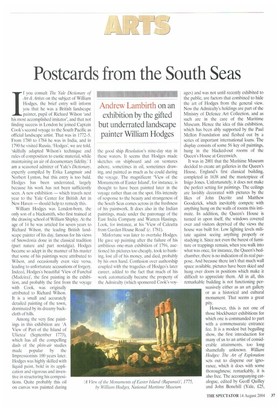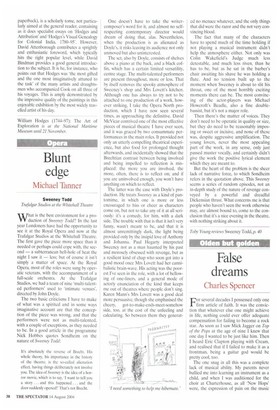Postcards from the South Seas
Andrew Lambirth on an exhibition by the gifted but underrated landscape painter William Hodges
1 f you consult The Yale Dictionary of Art & Artists on the subject of William Hodges, the brief entry will inform you that he was a British landscape painter, pupil of Richard Wilson 'and his most accomplished imitator', and that not finding success in London he joined Captain Cook's second voyage to the South Pacific as official landscape artist. That was in 1772-5. From 1780 to 1784 he was in India, and in 1790 he visited Russia. 'Hodges', we are told, 'skilfully adapted Wilson's technique and rules of composition to exotic material, while maintaining an air of documentary fidelity.' I am a seasoned admirer of Yale's Dictionary, expertly compiled by Erika Langmuir and Norbert Lynton, but this entry is too bald. Hodges has been underrated, largely because his work has not been sufficiently seen. A new exhibition — which travels next year to the Yale Center for British Art in New Haven — should help to remedy this.
William Hodges was London-born, the only son of a blacksmith, who first trained at the drawing school of William Shipley. At the age of 14 he was articled for seven years to Richard Wilson, the leading British landscape painter of his day, famous for his views of Snowdonia done in the classical tradition (part nature and part nostalgia). Hodges became so adept in the manner of his master that some of his paintings were attributed to Wilson, and occasionally even vice versa, leading to unfortunate accusations of forgery. Indeed, Hodges's beautiful 'View of Funchal (Madeira)', the first painting in the exhibition, and probably the first from the voyage with Cook, was originally attributed to Richard Wilson. It is a small and accurately detailed painting of the town, dominated by its dreamy backcloth of hills.
Among the very fine paintings in this exhibition are 'A View of Part of the Island of Ulietea' (September 1773), which has all the compelling dash of the plein-air studies made popular by the Impressionists 100 years later. Hodges was highly skilled with liquid paint, bold in its application and vigorous and inventive in structuring his compositions. Quite probably this oil on canvas was painted during
the good ship Resolution's nine-day stay in these waters. It seems that Hodges made sketches on shipboard and on ventures ashore, sometimes in oil, sometimes drawing, and painted as much as he could during the voyage. The magnificent 'View of the Monuments of Easter Island', for instance, is thought to have been painted later in the voyage rather than on the spot. His intensity of response to the beauty and strangeness of the South Seas comes across in the freshness of his painhvork. It does also in the Indian paintings, made under the patronage of the East India Company and Warren Hastings. Look, for instance, at his 'View of Calcutta from Garden House Road' (c. 1781).
Misfortune was later to overtake Hodges. He gave up painting after the failure of his ambitious one-man exhibition of 1794, auctioned his pictures too cheaply, took to banking, lost all of his money, and died, probably by his own hand. Confusion over authorship coupled with the tragedies of Hodges's later career, added to the fact that much of his work automatically became the property of the Admiralty (which sponsored Cook's voy
ages) and was not until recently exhibited to the public, are factors that combined to hide the art of Hodges from the general view. Now the Admiralty's holdings are part of the Ministry of Defence Art Collection, and as such are in the care of the Maritime Museum. Hence the idea of this exhibition, which has been ably supported by the Paul Mellon Foundation and fleshed out by a series of important international loans. The display consists of some 56 key oil paintings, hung in the blacked-out rooms of the Queen's House at Greenwich.
It was in 2001 that the Maritime Museum decided to create art galleries in the Queen's House, England's first classical building, completed in 1638 and the masterpiece of 'nig° Jones. Unfortunately, it does not make the perfect setting for paintings. The ceilings are lavishly decorated with pictures by the likes of John Decritz and Matthew Gooderick, which inevitably compete with anything hung on the walls of rooms this intimate. In addition, the Queen's House is turned in upon itself, the windows covered over and visitors deprived of the views the house was built for. Low lighting levels militate against seeing anything properly or studying it. Since not even the barest of furniture or trappings remain, when you walk into what was once, for instance, the Queen's bedchamber, there is no indication of its real purpose. And because there isn't that much wall space available, pictures have been skied and hung over doors in positions which make it difficult to appreciate them. All in all, this remarkable building is not functioning persuasively either as an art gallery or as a historical and cultural monument. That seems a great pity.
However, this is not one of those blockbuster exhibitions for which one is commanded to part with a commensurate entrance fee. It is a modest but beguiling show, the first introduction for many of us to an artist of considerable attainments, too long shamefully unknown. William Hodges: The Art of Exploration sets out to disperse our ignorance, which it does with some thoroughness; remarkably, it is also free. The accompanying catalogue, edited by Geoff Quilley and John Bonehill (Yale, £25, paperback), is a scholarly tome, not particularly aimed at the general reader, containing as it does specialist essays on 'Hodges and Attribution' and 'Hodges's Visual Genealogy for Colonial India, 1780-95'. However, David Attenborough contributes a sprightly and enthusiastic foreword, which typically hits the right popular level, while David Bindman provides a good general introduction to the subject. It is he, for instance, who points out that Hodges was 'the most gifted and the one most imaginatively attuned to the task' of the many artists and draughtsmen who accompanied Cook on all three of his voyages. This is amply demonstrated by the impressive quality of the paintings in this enjoyable exhibition by the most widely travelled artist of his day.
William Hodges (1744-97): The Art of Exploration is at the National Maritime Museum until 21 November.



























































 Previous page
Previous page